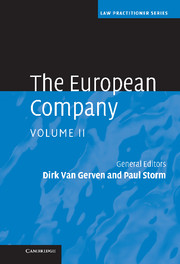9 - Luxembourg
from Part II - Application in each Member State
Published online by Cambridge University Press: 06 July 2010
Summary
Introduction
The Regulation and the Directive were implemented in the Grand Duchy of Luxembourg (‘Luxembourg’) by the Act of 25 August 2006 on the SE (the ‘SE Act’) amending the law of 10 August 1915 on commercial companies (the ‘CCL’), as amended, and an act of the same date supplementing the statute of the SE with regard to employee involvement (the ‘Employee Involvement Act’).
Reasons to opt for an SE
The main advantage of the SE over national corporate forms undoubtedly lies in its European character, which could prove to be a useful marketing tool for companies active across borders.
Indeed, the SE could become an attractive vehicle to allow multinationals to combine their pan-European activities into, for instance, a holding SE, considering that an SE is easier to relocate, if necessary, based on the provisions for the transfer of its registered office.
Moreover, until implementation of the Tenth Company Law Directive on cross-border mergers, the SE represents a significantly more flexible vehicle for cross-border transactions than national corporate forms in Luxembourg.
The foreseeable practical difficulties arising from implementation of the provisions on employee involvement could, in certain circumstances, limit the SE's success.
Formation
General remarks
Founding parties
As a result of enactment of the option in Article 2(5) of the Regulation, companies having their registered office, but not their head office, in a Member State can still participate in the setting up of an SE provided they have been incorporated in accordance with the laws of a Member State and they have a continuous link with the economy of a Member State (Art. 26bis (4) CCL).
- Type
- Chapter
- Information
- The European Company , pp. 252 - 287Publisher: Cambridge University PressPrint publication year: 2008

